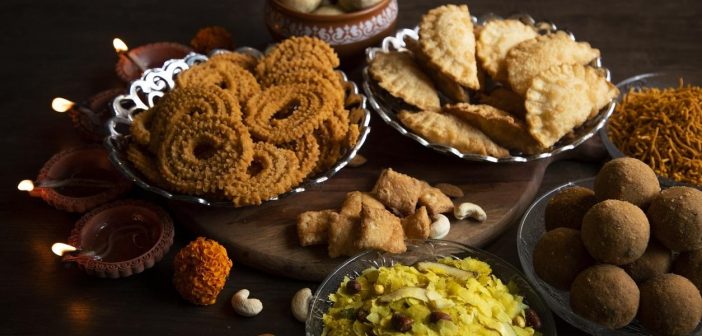Diwali, the festival of lights, is celebrated with great enthusiasm across India, and the culinary traditions associated with it are rich and diverse. One of the standout features of this celebration, particularly in Maharashtra, Goa, and coastal Karnataka, is Faral—a collection of snacks and sweets that are not only integral to the festivities but also reflect the cultural heritage of the region.
What is Diwali Faral?
Faral refers to the assorted snacks and sweets prepared during Diwali, often shared with friends and family as part of the celebration. The term itself is derived from the Marathi word “phara,” which means to offer or distribute. These delicacies are made using traditional recipes, and their preparation often begins weeks in advance. The essence of Faral lies in its variety, encompassing both sweet and savory items, each with its unique flavor profile.
Traditional Items in Diwali Faral
- Chakli: A spiral-shaped snack made from rice flour and lentil flour, chakli is deep-fried to achieve a crunchy texture. It’s seasoned with spices like sesame seeds and ajwain (carom seeds), making it a popular savory treat during Diwali.
- Karanji (or Gujiya): This crescent-shaped pastry is filled with a mixture of grated coconut, jaggery, and dry fruits. Karanji is a must-have sweet during the festival and symbolizes prosperity.
- Nuts and Chivda: A mixture of puffed rice, peanuts, and spices, chivda is a staple in many homes during Diwali. It’s both a snack and a side dish, often enjoyed with tea.
- Ladoos: Various types of ladoos, such as besan ladoo (made from gram flour) and coconut ladoo, are prepared and distributed among family and friends. These sweets symbolize love and sharing.
- Shankarpale: These diamond-shaped cookies made from flour and sugar are popular among children and adults alike. Dusting them with powdered sugar gives them a festive touch.
- Gulgule: Sweet dumplings made from flour and jaggery, gulgule are often served with milk or kheer during the festive season.
The Preparation Process
The preparation of Faral involves a significant amount of time and effort. Families often gather to make these treats, which not only fosters a sense of community but also preserves traditional culinary practices. The process usually begins a few weeks before Diwali, with ingredients such as rice flour, gram flour, jaggery, and various spices being procured in advance.
Once the preparations are complete, families engage in sharing these delicacies with neighbors and friends, reinforcing the spirit of togetherness and community that defines Diwali. Many families also include poha (flattened rice) in their Diwali feasts, with various preparations like goad fov (sweet poha) and batat fov (spicy poha) serving as staples during the festive period.
Variations Across Regions
While the core items remain largely consistent, there are regional variations in the recipes and methods of preparation. For instance, in Goa, the tradition of using poha and usal (a legume-based curry) is prevalent during Diwali, complementing the Faral snacks. Goan cuisine leans towards a simpler fare, emphasizing fresh ingredients and moderate spice levels, unlike the more indulgent preparations found in Maharashtra.
In coastal Karnataka, similar snacks are prepared, with the inclusion of local flavors and ingredients that reflect the region’s culinary heritage. The use of coconut in many dishes highlights the agricultural practices of the area, where coconut palms are abundant.
Customs and Significance
Faral is not merely about the food; it is deeply intertwined with the customs and rituals of Diwali. The act of preparing and sharing Faral symbolizes hospitality and goodwill, serving as a means to strengthen bonds within families and communities. Many families also offer these snacks to deities during their pujas (prayer rituals), seeking blessings for prosperity and health.
In addition, the variety and abundance of Faral reflect the wealth of nature and the blessings of the harvest season, making it a significant aspect of the Diwali celebration. Each item has its own story and symbolism, contributing to the rich tapestry of Indian culture.
.Conclusion
Diwali Faral represents a beautiful blend of tradition, community, and culinary art that is celebrated across Maharashtra, Goa, and coastal Karnataka. The diverse array of snacks and sweets not only delights the palate but also enriches the cultural heritage associated with the festival. As families prepare these treats, they not only honor their customs but also foster a sense of unity and joy that is essential to the spirit of Diwali.
This festive season, as homes light up and the aroma of freshly made Faral wafts through the air, it serves as a reminder of the importance of tradition, family, and community, encapsulating the essence of Diwali celebrations in Western India.






